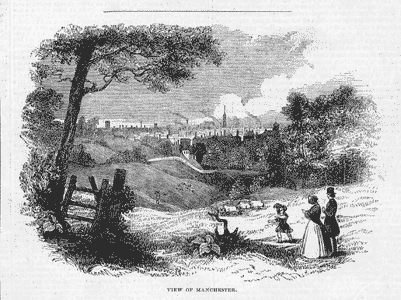|

NOTES ON ISSUE 1: HISTORICAL GLOSSARY
PART 4 OF 4
Adam Smith and Malthus,
two younger Gradgrinds
The two little Gradgrinds are both named for well-known political
economists. Adam Smith (1723-90) was the author of The Wealth
of Nations and is often considered the father of laissez-faire
capitalist thinking. Thomas Malthus (1766-1834) is best known
for his work on the question of overpopulation, the 1798 Essay
on the Principle of Population, a controversial work that
caused a public reaction against political economy.
Coketown, to which Messrs. Bounderby
and Gradgrind now walked, was a triumph of fact… It was
a town of red brick, or of brick that would have been red if
the smoke and ashes had allowed it; but as matters stood it
was a town of unnatural red and black like the painted face
of a savage. It was a town of machinery and tall chimneys, out
of which interminable serpents of smoke trailed themselves forever
and ever, and never got uncoiled. It had a black canal in it,
and a river that ran purple with ill-smelling dye, and vast
piles of building full of windows where there was a rattling
and a trembling all day long…
Dickens's Coketown, a northern cotton-manufacturing city, is
generally assumed to be Manchester, but he was somewhat more
familiar with Birmingham than with the former city. Although
Dickens toured Manchester and other northern towns—and had visited
the town of Preston during its long strike, just months before
the publication of Hard Times began—he did not have the
intense knowledge of and identification with any of the northern
cities that he did with London. An 1824 map of Manchester and
a nineteenth-century map of Birmingham (exact date unknown)
give a sense of the layout of each city.

Click
on map for larger view
The general description of an industrial
Hell that Dickens creates for Coketown are, however, based on
an amalgam of the several such cities Dickens had visited, and
have a good deal of allegorical power, as in the image of "interminable
serpents of smoke." The industrial towns were certainly smoky,
as shown in this view of Manchester from the Illustrated
London News of August 20, 1842. 
they lived upon the best, and
bought fresh butter, and insisted on Mocha coffee, and rejected
all but prime parts of meat, and yet were eternally dissatisfied
and unmanageable.
Although in this passage the "gentlemen" of Coketown
assert that the working class had access to the best foodstuffs
and were dissatisfied in spite of it, the truth is quite different.
Many workers could afford little to eat besides bread. Fresh
butter, for instance, was all but unobtainable for the poor;
instead, when they could afford it, they bought cheaper (and
older) salted butter, preserved in casks. Mocha coffee is a
high-quality type that was also unaffordable for the working
classes; imports of coffee were highly taxed, and as a consequence
the poor drank coffee that was mixed with the cheaper chicory.
Moreover, the adulteration of food was common in Victorian times.
Coffee, for instance, might be cut with various burnt or roasted
items, such as corn. Tea was similarly meddled with or the leaves
resold after being used. Flour for bread was eked out with chalk
or alum. Mrs Beeton's Book of Household Management (1861)
offers a rather casual aside: "The commonest adulterations
of milk are not of a hurtful character. It is a good deal thinned
with water, and sometimes thickened with a little starch, or
coloured with yolk of egg, or even saffron; but these processes
have nothing murderous in them." More harmful adulterations
included the use of poisonous red lead to color certain foods.
People who lived in the country or who had access to fresh foods
from farms were not as subject to the vagaries of the commercial
food supply as Victorian city dwellers. But those who were less
well off, in particular, could not be confident in the purity
or quality of the food they ate.
"What have you got
in that bottle you are carrying? "Gin," said Mr. Bounderby.
"Dear, no, sir! It's the nine oils."
Gradgrind's question, and Bounderby's assumption that Sissy
Jupe is carrying a bottle of gin for her father, are typical
of certain middle-class stereotypes of lower- or working-class
habits in the mid-nineteenth century. Gin was considered a distinctly
lower-class drink, available in disreputable "gin palaces"
and thought to go hand in hand with other vices of the poor.
The middle and upper classes were more likely to drink wine
and fortified wines such as port and sherry.
Sissy's reply that she is carrying "the nine oils"
seems to imply that she is somewhat shocked at the idea that
she might have gin with her. The nine oils was a preparation
mainly used in veterinary medicine, for treating horses, but
circus performers also used it to rub over bruises. According
to one nineteenth-century druggists' book, oils used in the
preparation included train oil, oil of turpentine, oil of bricks,
oil of amber, spirit of camphor, Barbadoes tar, and oil of vitriol.
|

